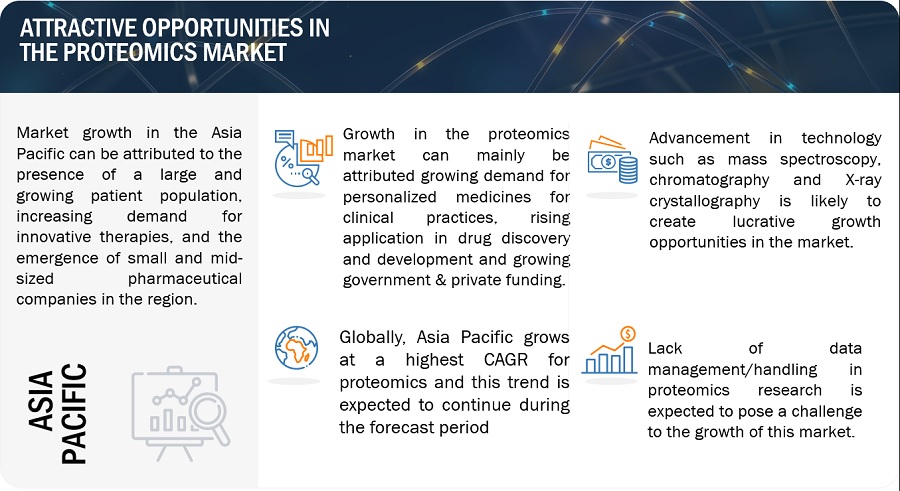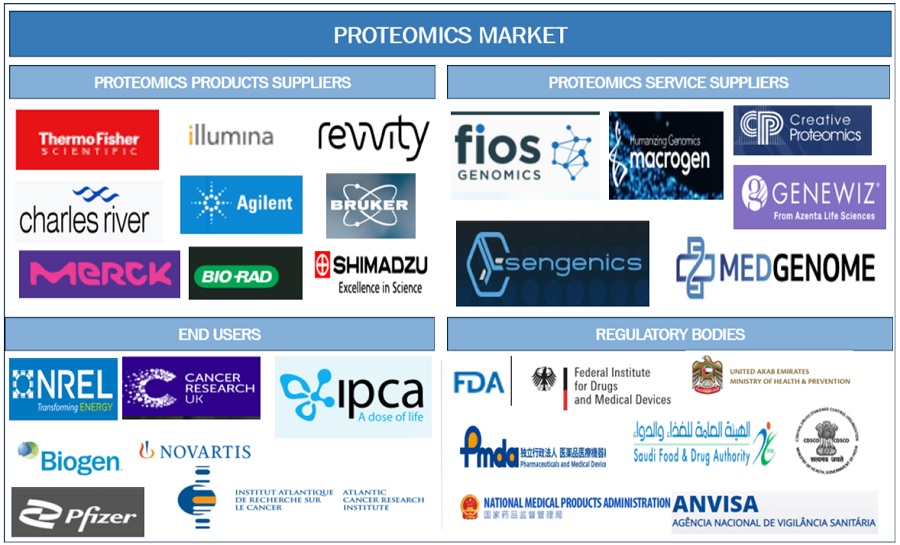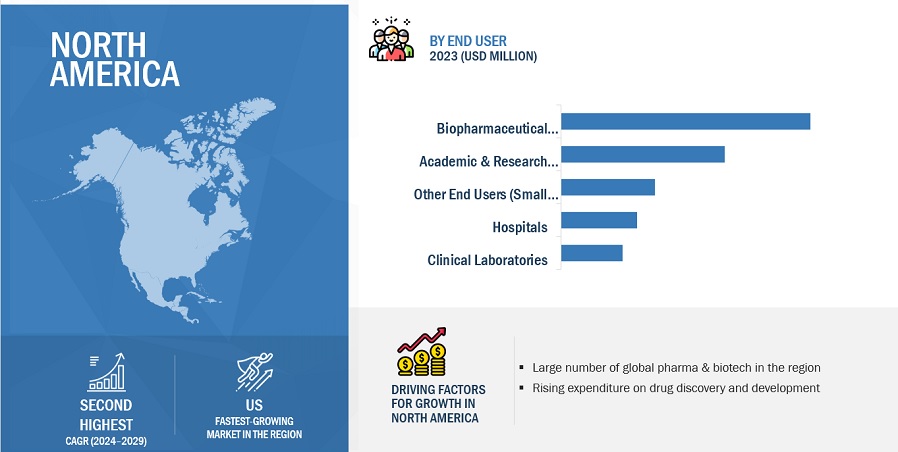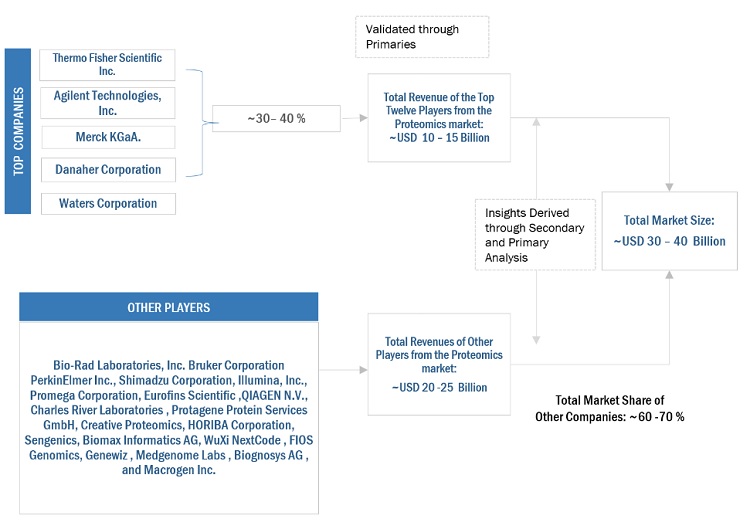Proteomics Market by Product (Spectroscopy, Chromatography, Electrophoresis, X-Ray Crystallography), Reagent, Service, (Core Proteomics, Bioinformatics), Application (Diagnostic, Drug Discovery), End User (Hospital, Labs, Biopharma) & Region - Global Forecast to 2029
Market Growth Outlook Summary
The global proteomics market growth forecasted to transform from USD 33.6 billion in 2024 to USD 60.5 billion by 2029, driven by a CAGR of 12.4%. The major factors driving growth in the proteomics market are the growing demand for personalized medicines for clinical practices, rising applications in drug discovery and development, growing government & private funding, clinical trial and translational research expansion, biologics and biosimilars development, increasing focus on monoclonal antibodies and therapeutic proteins, and improved techniques in protein quantification. Additionally, advancements in single-cell proteomics and bioinformatics are further driving the growth of the proteomics market.
Proteomics Market Trends

To know about the assumptions considered for the study, Request for Free Sample Report
Attractive Opportunities in the Proteomics Market

Proteomics Market Dynamics
Driver: Rising demand for personalized medicine
Proteomics plays an important role in personalized medicine by providing insights at the molecular level. The results make it possible to implement targeted therapies to support individualized medicine through biomarker discovery, identification of drug targets, and follow-up of therapy responses. During the last decade, there has been an increased usage of personalized medicines. In 2021, the FDA's Centre for Drug Evaluation and Research approved 50 novel molecular entities, all but 2 of which were therapeutic goods. Similarly, in 2022, the US FDA approved around 37 NMEs.
Restraints: High cost of instruments
One of the major factors limiting the growth of the proteomics market is the requirement of high investments initially. These are highly sophisticated, fully automated systems, with a relatively high capital expenditure towards procurement, installation, and integration into existing lines of production. This can be very expensive, owing to which raising the stake is quite hard for small and medium-sized enterprises, which form a large part of the manufacturing industry. Although these companies play an important role in product quality and regulatory compliance, steep costs may deter them from adopting essential instruments. Mass spectrometers and chromatography systems are examples of advanced proteomic tools, but they come at a cost. For example, state-of-the-art mass spectrometers run into several hundred thousand dollars—thus posing a considerable expense for research institutions and biotech companies. For example, only reagents for running a single mass spectrometry analysis can be in the range of USD 100–300. The cost in terms of specialists can also run into thousands of dollars a year for institutions if hiring and training are to be done. For small research labs or academic institutions, such expenses are unaffordable.
Opportunity: Advancements in bioinformatics
Advancements in bioinformatics are a key factor driving growth in the proteomics market. Some major technological advancements are software tools for data analysis and interpretation, such as MaxQuant and Proteome Discoverer, that enhance accuracy and speed in identifying and quantifying proteins from mass spectrometry data. Such tools help in the fast, parallel analysis of comprehensive datasets and in predicting the subtle interactions of proteomes and pathways. Technologies in bioinformatics, like computational proteomics and next-generation sequencing technologies, are revolutionizing biological and clinical research. Mass spectrometry allows for high-throughput and exact protein analysis, and NGS allows for fast, inexpensive sequencing of samples to reveal deviations, providing complete transcriptome profiles and identifying microbes. Among the NGS technologies, metagenomic NGS is best suited to detect pathogenic organisms in extremely complex samples. Furthermore, machine learning and artificial intelligence are currently changing the bioinformatics applications in proteomics. For prototyping exact precision in predicting protein structures, functions, and interactions, state-of-the-art algorithms harnessed from artificial intelligence, such as AlphaFold by DeepMind, are increasingly being used. They also empower fast turnaround for designing drug targets and therapeutic molecules.
Challenge: Lack of data management/handling in proteomics research
Although there is a huge volume of proteomics data that is available, the challenge in this market lies in the access and efficient utilization of the same. Poor data management can have a deleterious effect on the outcome of research and may actually turn out to be a growth inhibitor for the market. Recent studies have pointed out that owing to the inefficient handling of data, the use of proteomics data in major applications such as biomarker discovery and drug development has been restricted. For example, researchers in a major biotech company were slowed down while trying to analyze high-throughput proteomics data in the identification of potential therapeutic targets. Such delays slow not only the progress in research but also lengthen the time it takes to translate such discoveries into actionable results, which prolongs the product development cycle. Moreover, the lack of standardization of data formats and lack of interoperability between proteomics platforms make the integration of data from different research initiatives or even institutions very difficult. Besides, high-throughput experiments generate proteomics data that require specialized expertise in processing and analysis. Researchers often invest a huge amount of time in the preprocessing and analysis of proteomics data in order to extract meaningful information. The absence of separation of sample numbers in proteomics repositories makes it extremely hard to formulate the necessary research queries.
Ecosystem Analysis of Proteomics Market

The spectroscopy segment dominated the proteomics industry in 2023.
The proteomics market is further segmented on the basis of instrumentation technology into spectroscopy, chromatography, mass spectrometry, electrophoresis, protein microarrays, X-ray crystallography, surface plasmon resonance, protein fractionation, and other technologies. The spectroscopy segment dominated the global proteomics market in 2023 and is likely to continue to do so throughout the forecast period. The growing adoption of spectroscopy techniques in proteomics research is a key factor driving market growth. This is due to their ability to provide valuable insights into protein structure, dynamics, interactions, and functions, among other critical aspects.
The immunoassay reagents segment of the proteomics industry is poised to exhibit substantial growth at a significant CAGR throughout the forecast period.
The proteomics market is further categorized by reagents into protein microarray reagents, spectroscopy reagents, X-ray crystallography reagents, chromatography reagents, electrophoresis reagents, immunoassay reagents, protein fractionation reagents, and other reagents. The wide availability of various reagents and the growing demand for reliable, specific, and rapid disease detection at early stages are likely to drive the market growth of immunoassay reagents.
North America dominated the global proteomics industry in 2023.
Based on region, the proteomics market is segmented into North America, Europe, the Asia Pacific, Latin America, and the Middle East & Africa. North America dominated the global proteomics market in 2023 and is likely to dominate throughout the forecast period. The presence of many pharmaceutical companies and the rising demand for precision medicines are likely to boost the market in the region. Additionally, the rising research funding further drives the growth of the proteomics market in North America.

Source: Expert Interviews, Secondary Research, Whitepapers, Journals, Magazines, and MarketsandMarkets Analysis
To know about the assumptions considered for the study, download the pdf brochure
The key players in the proteomics market include Thermo Fisher Scientific Inc. (US), Agilent Technologies, Inc. (US), Merck KGaA (Germany), Danaher Corporation (US), Waters Corporation (US), Bio-Rad Laboratories, Inc. (US), Bruker Corporation (US), Revvity (US), Shimadzu Corporation (Japan), Illumina Inc. (US), Promega Corporation (US), Eurofins (Luxembourg), QIAGEN (Netherlands), Charles River Laboratories (US), and Protagene (Germany), among others.
Scope of the Proteomics Industry
|
Report Metric |
Details |
|
Market Revenue Size in 2024 |
$33.6 billion |
|
Projected Revenue Size by 2029 |
$60.5 billion |
|
Industry Growth Rate |
Poised to Grow at a CAGR of 12.4% |
|
Market Driver |
Rising demand for personalized medicine |
|
Market Opportunity |
Advancements in bioinformatics |
This report categorizes the proteomics market to forecast revenue and analyze trends in each of the following submarkets:
By Instrumentation Technology
-
Spectroscopy
- Mass Spectrometry
- NMR Spectroscopy
- CD Spectroscopy
-
Chromatography
- HPLC Chromatography
- Ion Chromatography
- Affinity Chromatography
- Superficial Chromatography
- Chromatography
-
Electrophoresis
- Gel Electrophoresis
- Capillary Electrophoresis
-
Protein Microarrays
-
Biochips
- Lab on chips
- Protein Chips
-
Microarray Instruments
- Integrated Systems
- Microarray Scanners
- Arrayers
-
Biochips
- X Ray Crystallography
- Surface Plasmon Resonance
- Protein Fractionation
- Other Technologies
By Reagent
- Immunoassay Reagents
- Spectroscopy Reagents
- Chromatography Reagents
- Protein Microarray Reagents
- X Ray Crystallography Reagents
- Electrophoresis Reagents
- Protein Fractionation Reagents
- Other Reagents
By Service
- Core Proteomics Services
- Bioinformatics Services
By Software
- Bioinformatics Tools
- Bioinformatics Databases
By Applications
- Clinical Diagnostics
- Drug Discovery & Development
- Other Applications
By End User
- Hospitals
- Clinical Laboratories
- Biopharmaceutical Companies
- Academic & Research Institutes
- Other End Users
By Region
-
North America
- US
- Canada
-
Europe
- Germany
- UK
- France
- Italy
- Spain
- Switzerland
- Rest of Europe
-
Asia Pacific
- China
- Japan
- India
- Australia
- South Korea
- Rest of Asia Pacific
-
Latin America
- Mexico
- Brazil
- Rest of Latin America
-
Middle East
-
GCC Countries
- Saudi Arabia
- UAE
- Rest of GCC
- Rest of Middle East
-
GCC Countries
- Africa
Recent Developments of Proteomics Industry
- In March 2024, Thermo Fisher Scientific Inc. (US) introduced the Thermo Scientific Stellar mass spectrometer (MS), a mass spectrometer that combines fast throughput and high sensitivity. This allows researchers to advance their translational omics research and make breakthrough discoveries more efficiently.
- In October 2023, Thermo Fisher Scientific Inc (US) acquired Olink Holdings (Sweden) with an aim to enhance Thermo Fisher’s capabilities in the high-growth proteomics market.
- In June 2024, Agilent Technologies, Inc. (US) launched two new products, the Agilent 7010D Triple Quadrupole GC/MS System and the Agilent ExD Cell available for the 6545XT AdvanceBio LC/Q-TOF, at the 72nd ASMS Conference on Mass Spectrometry and Allied Topics to advance gas chromatography-mass spectrometry (GC/MS) and LC/Q-TOF technology.
- In June 2024, Danaher Corporation (US) and Mass Analytica (Spain) collaborated to reveal artificial intelligence quantitation (AI quant) software, which offers high-resolution MS/MS analysis with an intelligent fragment selection algorithm.
- In February 2023, Waters Corporation (US) acquired Wyatt Technology (US), which enhanced the portfolio of separation and detection and provided customers with an unmatched set of analytical solutions across a wide range of applications.
Frequently Asked Questions (FAQ):
What is the projected growth rate of the global proteomics market between 2024 and 2029?
The global proteomics market is projected to grow from USD 33.6 billion in 2024 to USD 60.5 billion by 2029, at a CAGR of 12.4%. The growth is driven by rising demand for personalized medicine, advancements in protein quantification, and an increasing focus on drug discovery and therapeutic development.
What are the key factors driving the proteomics market?
Key drivers of the proteomics market include the increasing application of proteomics in personalized medicine, rising investments in drug discovery, and advancements in bioinformatics tools. Additionally, growing clinical trials and translational research are contributing to market growth.
What challenges are restraining the growth of the proteomics market?
One of the major challenges in the proteomics market is the high cost of instruments and equipment like mass spectrometers and chromatography systems. Additionally, there are challenges related to the lack of proper data management and integration of high-throughput proteomics data.
Which region is expected to dominate the proteomics market in the forecast period?
North America is expected to dominate the proteomics market during the forecast period, driven by the presence of major pharmaceutical companies, increasing research funding, and the rising adoption of precision medicine.
How does the increasing demand for personalized medicine impact the proteomics market?
The rising demand for personalized medicine is significantly driving the proteomics market. Proteomics enables the identification of biomarkers, drug targets, and therapy response mechanisms, which are critical for the development and implementation of individualized treatments.
What are the recent technological advancements in the proteomics market?
Recent technological advancements in the proteomics market include the introduction of advanced mass spectrometry systems, improved bioinformatics tools for protein quantification, and AI-based algorithms such as AlphaFold for accurate prediction of protein structures and functions.
What opportunities are available for growth in the proteomics market?
Advancements in bioinformatics, such as next-generation sequencing (NGS) technologies and computational proteomics, present significant opportunities for growth in the proteomics market. These technologies are revolutionizing drug discovery, diagnostics, and precision medicine.
How does the high cost of instruments affect the proteomics market?
The high cost of instruments such as mass spectrometers and chromatography systems poses a significant barrier to market growth, particularly for small and medium-sized enterprises (SMEs) and research institutions that may find it challenging to afford these advanced tools.
What role does bioinformatics play in the proteomics market?
Bioinformatics plays a crucial role in the proteomics market by enabling the analysis and interpretation of large-scale proteomics data. Advanced software tools like MaxQuant and Proteome Discoverer are enhancing the speed and accuracy of protein identification and quantification.
How are academic and research institutes contributing to the proteomics market?
Academic and research institutes play a significant role in driving the proteomics market by conducting fundamental research in protein structure and function, developing new analytical techniques, and contributing to advancements in drug discovery and diagnostics.
To speak to our analyst for a discussion on the above findings, click Speak to Analyst

This study involved four major activities in estimating the current size of the proteomics market. Exhaustive secondary research was carried out to collect information on the market, its peer markets, and its parent market. The next step was to validate these findings, assumptions, and sizing with industry experts across the value chain through primary research. The top-down and other approaches were employed to estimate the complete market size (proteomics market size). After that, market breakdown and data triangulation procedures were used to estimate the market size of segments and subsegments.
Secondary Research
Secondary research was used mainly to identify and collect information for the extensive, technical, market-oriented, and commercial study of the proteomics market. The secondary sources referred to for this research study include publications from government and private sources such as the Indian Pharmaceutical Association (IPA), the Pharmaceutical Research and Manufacturers of America (PhRMA), the European Federation of Pharmaceutical Industries and Associations (EFPIA), Central Drugs Standard Control Organization (CDSCO), Indian Brand Equity Foundation (IBEF), European Medicines Agency (EMA), Global Cancer Observatory (GCO), American Chemical Society (ACS), National Center for Biotechnology Information (NCBI), Food and Drug Administration (FDA), Biotechnology and Biological Sciences Research Council (BBSRC), Pharmaceutical Research and Manufacturers of America (PhRMA), and the World Journal of Pharmaceutical Sciences, Company Websites, Annual Reports, SEC Filings, Press Releases, Investor Presentations, Journals, Expert Interviews, MarketsandMarkets Analysis. Secondary data was collected and analyzed to arrive at the overall size of the global proteomics market, which was then validated by primary research.
Primary Research
In-depth interviews were conducted with various primary respondents, including key industry participants, subject-matter experts (SMEs), C-level executives of key market players, and industry consultants, among other experts, to obtain and verify the critical qualitative and quantitative information as well as assess future prospects of the market. Various primary sources from both the supply and demand sides of the market were interviewed to obtain qualitative and quantitative information. The following is a breakdown of the primary respondents:

To know about the assumptions considered for the study, download the pdf brochure
Proteomics Market Size Estimation
A top-down approach was used to estimate and validate the total size of the proteomics market. This method was also used extensively to estimate the size of various subsegments in the market. The research methodology used to estimate the total proteomics market size includes the following:
- The key players in the industry and market have been identified through extensive secondary research
- The revenues generated from the proteomics business of leading players have been determined through primary and secondary research
- All percentage shares, splits, and breakdowns have been determined using secondary sources and verified through primary sources

To know about the assumptions considered for the study, Request for Free Sample Report
Global Proteomics market size: Top-Down Approach

Data Triangulation
After arriving at the overall proteomics market size from the market size estimation process, the total market was split into several segments and subsegments. To complete the overall market engineering process and arrive at the exact statistics for all segments and subsegments, data triangulation and market breakdown procedures were employed, wherever applicable. The data was triangulated by studying various factors and trends from both the demand and supply sides.
Market Definition
Proteomics is the complete evaluation of the structure and function of proteins to understand an organism’s nature. It is the systemic identification and characterization of proteins along with their sequence, abundance, post-translational modifications, interactions, activity, subcellular localization, and structure. The market study includes the assessment of various instruments, reagents, software, and services used in proteomics.
Key Stakeholders
- Life sciences instrumentation and reagent companies
- Pharmaceutical and biotechnology companies
- Proteomics database and software providers
- Proteomics service providers
- Research and consulting firms
- Academic medical centers
- Government research organizations
- Clinical research institutes
- Contract Research Organizations
Report Objectives
- To define, describe, and forecast the global proteomics market based on the instrumentation technologies, reagents, software & services, application, end-user, and region
- To provide detailed information regarding the major factors influencing the growth of the market (such as drivers, restraints, challenges, and opportunities)
- To strategically analyze micro markets with respect to individual growth trends, future prospects, and contributions to the overall proteomics market
- To analyze opportunities in the market for stakeholders and provide details of the competitive landscape for market leaders
- To forecast the size of the market segments with respect to five main regions, namely, North America, Europe, Asia Pacific, Latin America, and Middle East & Africa.
- To strategically profile the key players and comprehensively analyze their product & service portfolios, market positions, and core competencies
- To track and analyze competitive developments such as product launches, acquisitions, expansions, agreements, collaborations, and R&D activities in the proteomics market.
Available Customizations
With the given market data, MarketsandMarkets offers customizations as per the company’s specific needs. The following customization options are available for this report:
Geographic Analysis
- Further breakdown of the Rest of Europe proteomics market into respective countries
- Further breakdown of the Rest of Asia Pacific proteomics market into respective countries
- Further breakdown of the Rest of Latin America proteomics market into respective countries
Company Information
- Detailed analysis and profiling of additional market players (Up to 5)
- An additional five company profiles



 Generating Response ...
Generating Response ...









Growth opportunities and latent adjacency in Proteomics Market
Looking to gain more insights on the global Proteomics Market
What are the growth opportunities in Proteomics Market?
Can you enlighten us on geographical growth analysis in Proteomics Market?